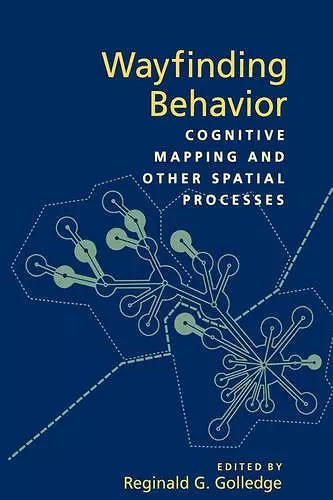Wayfinding Behavior
Cognitive Mapping and Other Spatial Processes
Format:Hardback
Publisher:Johns Hopkins University Press
Published:14th Jan '99
Currently unavailable, and unfortunately no date known when it will be back

Wayfinding Behavior: Cognitive Mapping and Other Spatial Processes incorporates cognitive, perceptual, neural and animal perspectives. The authors come from a variety of disciplinary backgrounds, yet the writing is accessible to a wide audience. The book represents an exciting and innovative addition to the cognitive mapping literature, and will be a standard reference for the next decade of cognitive map research. -- Stephen Hirtle, University of Pittsburgh
"The more we know,concludes volume editor Reginald Golledge, "about how humans or other species can navigate, wayfind, sense, record and use spatial information, the more effective will be the building of future guidance systems, and the more natural it will be for human beings to understand and control those systems."The metaphor of a "cognitive map"has attracted wide interest since it was first proposed in the late 1940s. Researchers from fields as diverse as psychology, geography, and urban planning have explored how humans process and use spatial information, often with the view of explaining why people make wayfinding errors or what makes one person a better navigator than another. Cognitive psychologists have broken navigation down into its component steps and shown it to be an interplay of neurocognitive functions, such as "spatial updating"and "reference frames"or "perception-action couplings."But there has also been an intense debate among biologists over whether animals have cognitive maps or have other forms of internal spatial representations that allow them to behave as if they did. Yet until now, little has been done to relate research on human and non-human subjects in this area. In Wayfinding Behavior: Cognitive Mapping and Other Spatial Processes Reginald Golledge brings together a distinguished group of scholars to offer a unique and comprehensive survey of current research in these diverse fields. Among the common themes they discover is the psychologists' "black box"approach, in which the internal mechanisms of spatial perception and route planning are modeled or constructed, like metaphors, based on the behavioral evidence. Cognitive neuroscientists, on the other hand, have attempted to discover the neurocognitive basis for spatial behavior. (They have shown, for example, that damage in the hippocampus system invariably impairs the ability of animals and humans to learn about, remember, and navigate through environments, and studies in humans show that neurons in this system code for location, direction, and distance, thereby providing the elements needed for a mapping system.) Artificial intelligence and robotics theorists attempt to construct intelligent mapping systems using computer technology. In these areas, there is growing evidence that, as in human wayfinding processes, useful representations cannot be achieved without sacrificing completeness and precision. Wayfinding Behavior: Cognitive Mapping and Other Spatial Processes offers not only state-of-the-art knowledge about "wayfinding, "but also represents a...
"'Wayfinding Behavior: Cognitive Mapping and Other Spatial Processes' incorporates cognitive, perceptual, neural and animal perspectives. The authors come from a variety of disciplinary backgrounds, yet the writing is accessible to a wide audience. The book represents an exciting and innovative addition to the cognitive mapping literature, and will be a standard reference for the next decade of cognitive map research."--Stephen Hirtle, University of Pittsburgh
ISBN: 9780801859939
Dimensions: 229mm x 152mm x 33mm
Weight: 822g
448 pages